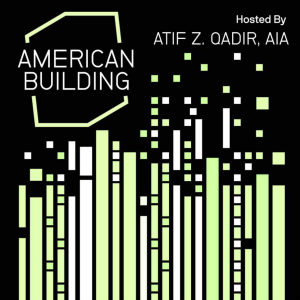
American Building
Arts & Culture Podcasts
If you want to explore urgent topics related to housing and what they can teach us about ourselves and our country, join us here at American Building. Your host, Atif Qadir, Atif Qadir is a licensed architect and entrepreneur, interested in solving big problems through innovation and technology. He has founded two proptech companies and a real estate development firm, building products ranging from software to workforce housing. Through these experiences, he has a unique perspective on the housing problems - and solutions - we’ll hear about this season. We’ll not only dive into the design and development of iconic buildings, but we’ll also analyze how federal and state policy, local entitlements, and access to capital and distribution are making it increasingly difficult to house Americans. Plus, we will be unpacking relevant news headlines and providing insight into the current legislation related to housing. Subscribe wherever you listen to podcasts.
Location:
United States
Genres:
Arts & Culture Podcasts
Description:
If you want to explore urgent topics related to housing and what they can teach us about ourselves and our country, join us here at American Building. Your host, Atif Qadir, Atif Qadir is a licensed architect and entrepreneur, interested in solving big problems through innovation and technology. He has founded two proptech companies and a real estate development firm, building products ranging from software to workforce housing. Through these experiences, he has a unique perspective on the housing problems - and solutions - we’ll hear about this season. We’ll not only dive into the design and development of iconic buildings, but we’ll also analyze how federal and state policy, local entitlements, and access to capital and distribution are making it increasingly difficult to house Americans. Plus, we will be unpacking relevant news headlines and providing insight into the current legislation related to housing. Subscribe wherever you listen to podcasts.
Language:
English
Contact:
3072775472
Green-Wood Cemetery’s Next Act
Duration:00:39:50
A New Take on Disaster Housing in Hawaiʻi (Part 2)
Duration:00:35:14
A New Take on Disaster Housing in Hawaiʻi (Part 1)
Duration:00:32:00
How Small-Scale Homes and Cottage Communities Address Middle-Income Housing Needs
Duration:01:00:05
Met Tower: Creating Five-Star Hotel Experiences in Office Buildings
Duration:00:44:39
Adaptive Reuse and Community Revitalization in Oklahoma City
Duration:00:48:04
How a Legendary Architecture Firm Transitions, Grows, and Looks Forward
Duration:01:04:12
How Aker’s Core Values Drive Redevelopment and Community at Kinwood
Duration:00:42:01
Transforming the Transamerica Pyramid and Reshaping Downtown San Francisco | Part 2
Duration:00:20:26
Transforming the Transamerica Pyramid and Reshaping Downtown San Francisco | Part 1
Duration:00:41:04
Studio Barn and Principles for Successful Adaptive Reuse
Duration:00:46:20
Building Aboard the World's Largest Residential Yacht
Duration:00:46:14
Bonus Replay: Improving the Work of a Legend | Part 2
Duration:00:43:43
Bonus Replay: Improving the Work of a Legend | Part 1
Duration:00:40:18
Adaptive Reuse and The Future of Retail
Duration:00:53:12
The Ponce City Market Approach to Sustainable Construction
Duration:00:36:36
Mass Timber and the Future of Sustainable Housing Development
Duration:00:50:30
The Housing Solution Hidden in Plain Sight
Duration:00:46:33
Why Trailborn is Betting On America’s Drive-To Destinations
Duration:00:50:40
Introducing American Building Season 4
Duration:00:02:17